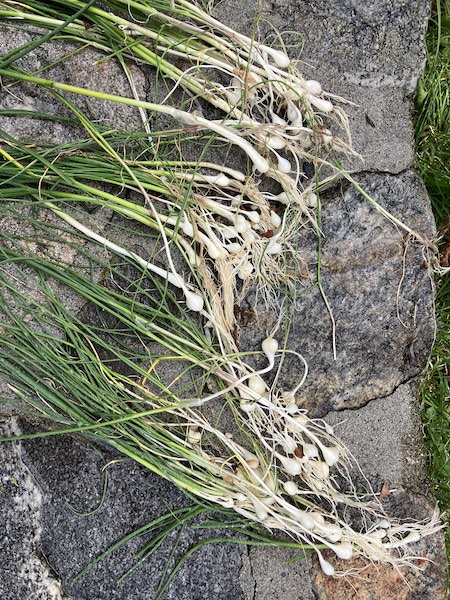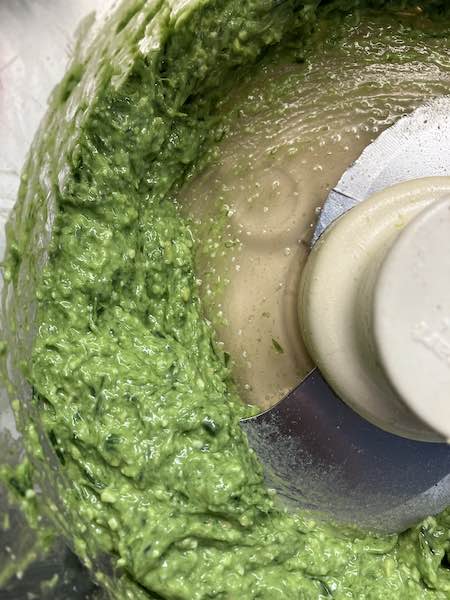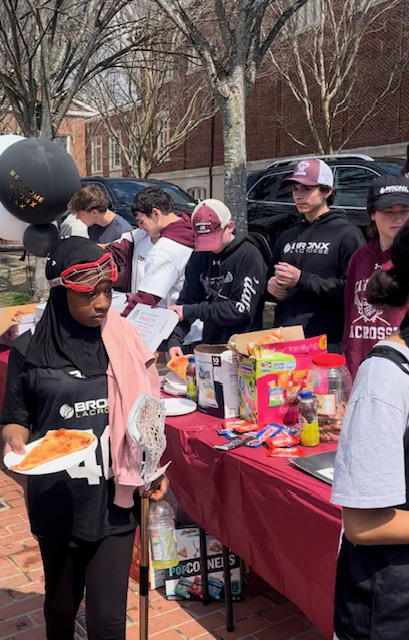First Harvest from My Yard: Onion Grass!
- Details
- Written by Lee Fischman
- Hits: 1176
 (Submitted by Lee Fischman)
(Submitted by Lee Fischman)
If you’re lucky enough to garden organically and have a bit of wildness left around your house, the first harvest of the season is upon us! Onion grass or wild garlic (Allium vineale) is easy to spot, as it shoots up first while the grass is still dormant. Upon inspection, it in fact looks a lot like chives. Break off a piece and if it smells garlicky, you’ll know you’ve got the real thing.
Onion grass is fully edible. In this article, I will walk you from harvest through a few ideas on what to do with them. First let me doubly emphasize that your garden must be organically tended.
Harvest onion grass by digging around them with a trowel, so that you pull up the full plant including its bulbs. Bigger, more mature onion grass = bigger bulbs. You can use a water hose to give them their first cleaning.
Now it’s time to take them indoors! I typically clean each strand under running water; it goes pretty quickly, especially if you’re meanwhile listening to NPR. While washing these, pull off any loose outer layers and the occasional woody portion. Next cut off the roots of the bulbs.
 This is followed by another snip just above the bulb and you’re left with these wonderful little things. To my palate, they taste like a cross between Jerusalem artichokes and garlic. I’m going to seed these through the kimchi I’m making.
This is followed by another snip just above the bulb and you’re left with these wonderful little things. To my palate, they taste like a cross between Jerusalem artichokes and garlic. I’m going to seed these through the kimchi I’m making.

Now you’re left with the stalk, which I usually divide in two. First there’s the tougher bottom part, which can be chopped up and used much like the bottoms of scallions.
The top parts are succulent greens, which taste like slightly garlicky chives.
 So far this season I’ve made these greens into a pesto, tossed them in pasta, and folded fold them into an omelette.
So far this season I’ve made these greens into a pesto, tossed them in pasta, and folded fold them into an omelette.


Bronx Lacrosse Scrimmages with Scarsdale Youth Lacrosse
- Details
- Written by Joanne Wallenstein
- Hits: 1731
 On Sunday, April 14, 2024, from 1:30-4:30 on the Scarsdale High School Turf, the Scarsdale Lacrosse Leadership Club hosted a successful Spring Scrimmage play day for Bronx Lacrosse and Scarsdale Youth Lacrosse. Bronx Lacrosse is a year-round academic and sports-based development program that uses lacrosse as a vehicle to improve educational opportunities and life outcomes for underserved middle school and high school students in the Bronx.
On Sunday, April 14, 2024, from 1:30-4:30 on the Scarsdale High School Turf, the Scarsdale Lacrosse Leadership Club hosted a successful Spring Scrimmage play day for Bronx Lacrosse and Scarsdale Youth Lacrosse. Bronx Lacrosse is a year-round academic and sports-based development program that uses lacrosse as a vehicle to improve educational opportunities and life outcomes for underserved middle school and high school students in the Bronx.
Bronx Lacrosse and Scarsdale Youth Lacrosse boys and girls 5/6 and 7/8 teams played in lacrosse games throughout the day. The Scarsdale Lacrosse Leadership Club at Scarsdale High School works to fundraise, donate equipment,and provide transportation costs to help build the growing program. Club Presidents, Colin Brennan and Jane Hoffman, raised funds for, organized, and executed the event by arranging and providing bussing to and from the Bronx for the players, pizza, snacks, drinks, music and welcoming enthusiasm throughout the day. Amore pizza in Scarsdale donated and delivered pizzas throughout the day. The communities came together to enjoy a great day of lacrosse.



Residents Ask the Planning Board to Protect the Neighborhood from Further Flooding
- Details
- Written by Joanne Wallenstein
- Hits: 2687
 Is it the charter of the Scarsdale Planning Board to protect neighbors in flood-prone areas when developers propose new projects that risk exacerbating area flooding? Or does the developer simply need to demonstrate that the proposed work will not cause more runoff from the property than is currently experienced, even if the area is already in trouble?
Is it the charter of the Scarsdale Planning Board to protect neighbors in flood-prone areas when developers propose new projects that risk exacerbating area flooding? Or does the developer simply need to demonstrate that the proposed work will not cause more runoff from the property than is currently experienced, even if the area is already in trouble?
That was the question at a meeting of the Planning Board on March 27, 2024 which became more of a referendum on the role of the board than a ruling on a controversial application for a subdivision.
At issue was an application to subdivide a lot at 101 Carthage Road and 46 Lincoln Road from two lots into three, to permit a third new home to be built on the property. This was the fourth hearing for the applicant, who came before the Planning Board on November 29. 2023, January 31, 2024, February 28, 2024 and March 26, 2024.
At each of the subsequent meetings, questions about drainage caused the board to hold over a decision.
The proposed site is wet and a pipe that runs through it currently ferries water from upstream to downstream areas of Mamaroneck Road. A neighbor showed a video of a rushing river on Lincoln Road from the property during the March 25 storm and feared that additional tree removals would endanger his home. His wife reported flooding and sewage in their basement from a brook that extends from 46 Lincoln past their home.
At this meeting the Village retained a consultant to review the hydraulics study produced by the applicant’s engineer. He proposes to move the drainage pipe into the street and make it the responsibility of the Village to maintain. He claims the stormwater improvement plan for the property will result in a 23% reduction in the amount of run off.
John Ruschke from the engineering firm Mott McDonald was not able to confirm the calculations provided by the applicant. He said, “They could be more conservative with their calculations and allow for the ponding” and “the drainage area that flows through this property is very large.”
About the size of the proposed drainage pipe he said, “If the bypass pipe is too large and increases the flow you are going to increase the flooding downstream. If there’s a smaller pipe, you are going to retain water and affect the upstream neighbors.”
When questioned about the possible risks to the neighborhood, Ruschke said, “A more sophisticated and regional study is needed if you want to improve the situation. They(the developer) are proposing to keep things status quo … you need a sophisticated model of the watershed – and everything upstream and downstream. It’s a more complex analysis.”
He suggested that two studies were needed: one of the proposed development site and another of the entire neighborhood and watercourse. Asked where his views and the proposed site design are consistent, Ruschke responded, “We are not on the same page. There is still a lot of validation that I need to do.”
Further questions were raised about the removal of 46 mature trees. Planning Board members asked whether or not the applicant could testify as to the difference in the water absorption of the existing mature trees vs. the 76 replacement trees. The landscape expert said that figure was “impossible to quantify.”
As it seems that more intensive rainstorms are occurring more frequently, Planning Board members asked if the calculations accounted for increased rainfall due to climate change?
Before allowing for public comments, Chairman Clapp asked the applicant to do further work with the consultants to “come up with a new plan.”
Neighbors, some who were now attending their fourth meeting, saw it another way. Some did not understand why the Planning Board did not vote to turn the applicant down for failing to demonstrate that the project would not cause further flooding.
Jessica Bandel of 99 Carthage Road said, “I am concerned about the Planning Board. You have all heard from us about the flooding. The flooding is an egregious problem.
David Goldschidt said, “If anybody walked the street on Saturday the amount and velocity of water coming down Carthage Road was significant. There needs to be attention to the drainage in this area. It needs to be underscored. Make sure the proposal does not harm the neighbors.” He also asked the Planning Board to consider the setbacks of the new homes to be sure they conform with the neighborhood.
Lynn Soares of 49 Lincoln Road said, “I brought a video. We have a brook rising on our property. We have had our furniture floating in 3 feet of sewage. It is irresponsible to say he is considering 50 Lincoln and not Carthage across the road. Think about the financial damage this could cause.” Nelson Soares said, “This is disappointing and frustrating. When you have independent engineers come in … we are talking about around our neighborhood. That should be taken into consideration. If you have lived with the problems in our basement …. we just got 2 inches this weekend and it was a disaster and there was only 1/12” to 2” causing a problem.” About the proposed third house on the property he said, “How can more building cause less water?”
Sanae Tenembaum of 52 Lincoln Road said, “I am not hearing with any certainty that things will not be worse. It is a delicate situation. You have heard from 20 neighbors. And that’s not even discussing the character of the neighbor. This is irresponsible. Let’s see the drainage improve after the construction of 2 new houses.
Cynthia Roberts said, “Grass absorbs more water than trees? Trees absorb exponentially more water than grass. How much water will these small trees absorb? There is iTree software that will allow you to calculate how much water a tree can absorb. Mature trees can absorb from 10 to 150 gallons a day. You have to assess the current situation and also take climate change into account. How have the calculations allowed for the uptake of the current trees?”
Jack Miller said, “This affects everyone on Carthage from Lincoln down to Mamaroneck Road. The best design would be a pond. If this fails it will take out neighbors and the fire house. This does not fit into our neighborhood. There is an eight-foot difference in elevation and a retaining wall between two different houses.
A resident from 139 Carthage Road said, “I am confused – last meeting we heard they are going to put in a bigger pipe – this time – a smaller pipe will control the water. What is the impact to our homes? We are in a precarious position. We have a lot of water. Adding another house is just going to make it worse. I don’t know where adding a house would make the water go away. There is no rush to add the third property. I am averse to having an impact all the way down the street.”
Helen Maccarino of 83 Cushman Road reported, “I never had floods in my basement and now we do. We lived there for 25 years. This Saturday, the hydrostatic pressure was pushing the water up through the floor. You identified some high-risk areas. When there is more development before the infrastructure is repaired it sends shivers through me. Consider holding off any multi-home subdivisions before you fix the problems.”
Elaine Weir said, “We have to plan for a future with more water – not match existing conditions.”
Joan Weissman said, “The fact that the proposed subdivision is flanked by two designated wetlands, one regulated by the Village of Scarsdale and the other regulated by the NYS DEC, magnifies the fragility of the area with respect to both stormwater runoff and ecological resources. Highlighting this issue is the 100-foot watercourse buffer that surrounds part of the proposed subdivision. Chapter 171 of the Village Code, which is entitled Freshwater Wetlands, states in part that "it is the intent of the Board of Trustees of the Village of Scarsdale that activities in and around freshwater wetlands... do not threaten public safety or the natural environment.” Redirecting a watercourse, building three houses that take up most of the surrounding green space, and clear-cutting scores of mature trees--that will take decades to be replaced in kind--certainly threaten both public safety and the natural environment by causing increased flooding and the destruction of the ecosystems that currently exist at the site. In the relevant Village Code chapters, the Board of Trustees clearly states its policy and intent to "protect its citizens and those of downstream communities, including future generations.” I urge the Planning Board to carry out the Trustees mandate and to deny the subdivision application.”
Architect Marcel P. Swigoniak Passes Away at 82
- Details
- Written by Joanne Wallenstein
- Hits: 1565
 Marcel P. SwigoniakWe are deeply saddened by the loss of Marcel P. Swigoniak of Eastchester on April 10, 2024, just six days before his 83rd birthday. Marcel was a man of optimism, courage, intellectual prowess and creativity. He was born in German occupied Poland during the height of World War II. He received a Masters of Architectural Engineering at the Politechnika Krakowska in Krakow, Poland. After several high level appointments as an architect including designing the Fiat automobile factory in Bielsko-Bliala, Poland he fell victim to the communist system and was replaced in his job by a Party member, as often was the case in pre-Solidarity Poland. Over time, he and his wife devised a clandestine plan to escape with their two small children from communist Poland in the mid 1970s. After a brief period in a refugee camp in Italy, he and his family received permission to immigrate to America in 1977. Marcel established his own architecture firm in the US and worked as a sole practitioner, including assisting in the design of his daughter’s and son-in-law’s house in Scarsdale, until a life-altering stroke ended his professional career. He is a member of American Institute of Architects (A.I.A.) and National Council of Architectural Registration Boards (NARB).
Marcel P. SwigoniakWe are deeply saddened by the loss of Marcel P. Swigoniak of Eastchester on April 10, 2024, just six days before his 83rd birthday. Marcel was a man of optimism, courage, intellectual prowess and creativity. He was born in German occupied Poland during the height of World War II. He received a Masters of Architectural Engineering at the Politechnika Krakowska in Krakow, Poland. After several high level appointments as an architect including designing the Fiat automobile factory in Bielsko-Bliala, Poland he fell victim to the communist system and was replaced in his job by a Party member, as often was the case in pre-Solidarity Poland. Over time, he and his wife devised a clandestine plan to escape with their two small children from communist Poland in the mid 1970s. After a brief period in a refugee camp in Italy, he and his family received permission to immigrate to America in 1977. Marcel established his own architecture firm in the US and worked as a sole practitioner, including assisting in the design of his daughter’s and son-in-law’s house in Scarsdale, until a life-altering stroke ended his professional career. He is a member of American Institute of Architects (A.I.A.) and National Council of Architectural Registration Boards (NARB).
He is survived by his wife of 60 years, Krystyna, his children, Alexandra Swigon and Agnieszka (Aggy) Shawn, son-in-law Peter Shawn and his grandchildren, Elizabeth, Emily and Jonathan.
Arrangements include Funeral Mass at Annunciation Church (470 Westchester Ave., Crestwood) on Saturday, April 13, at 10am with the Burial following at 11:15am at Gate of Heaven Cemetery (10 W. Stevens Avenue, Hawthorne).
Scarsdale’s Gas Blower Ban Continues
- Details
- Written by Joan Weissman
- Hits: 5882
 Landscaping spring clean-up has begun, and Scarsdale's gas-powered leaf blower ban continues to be in full effect. From January 1st through September 30th the use of gas-powered leaf blowers is prohibited. Electric blowers--corded and battery--are allowed throughout the year.
Landscaping spring clean-up has begun, and Scarsdale's gas-powered leaf blower ban continues to be in full effect. From January 1st through September 30th the use of gas-powered leaf blowers is prohibited. Electric blowers--corded and battery--are allowed throughout the year.
Scarsdale's gas-powered leaf blower ban was enacted after many years of residents advocating in favor of its passage. In mitigating both noise and air pollution, the law greatly benefits both residents and the landscapers who perform the work on a daily basis.
Residents who employ landscapers should remind them to use electric leaf blowers. The use of gas leaf blowers is subject to a fine.
The best way to report violations is to email the Building Department at building@scarsdale.com and include photos of the landscaper’s truck with their information. That way the landscaper can be informed of the law. Residents may also call the Building Department Monday through Friday from 9am to 5pm at 914-722-1140 and are encouraged to follow up with an email. At all other times residents may call the Police Department at its non-emergency number, 914-722-1200.
With the law's enactment, the quality of life in the village has greatly improved, and it is important to keep this momentum going strong.














